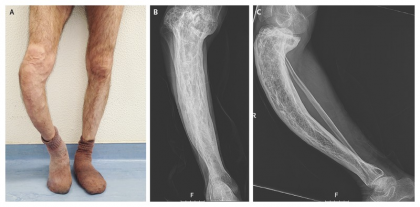- Home
- Editorial
- News
- Practice Guidelines
- Anesthesiology Guidelines
- Cancer Guidelines
- Cardiac Sciences Guidelines
- Critical Care Guidelines
- Dentistry Guidelines
- Dermatology Guidelines
- Diabetes and Endo Guidelines
- Diagnostics Guidelines
- ENT Guidelines
- Featured Practice Guidelines
- Gastroenterology Guidelines
- Geriatrics Guidelines
- Medicine Guidelines
- Nephrology Guidelines
- Neurosciences Guidelines
- Obs and Gynae Guidelines
- Ophthalmology Guidelines
- Orthopaedics Guidelines
- Paediatrics Guidelines
- Psychiatry Guidelines
- Pulmonology Guidelines
- Radiology Guidelines
- Surgery Guidelines
- Urology Guidelines
Case Report of Saber Tibia in Paget's Disease of Bone

Maria João Gonçalves and associates have reported a Case Report of Saber Tibia in Paget's Disease of Bone which has appeared in NEJM Case Reports.
Paget's Disease of Bone is a chronic progressive disease of osteoblasts and osteoclasts which results in abnormal bone remodeling. Over time, the disease can cause affected bones to become fragile and misshapen. Paget's disease of bone most commonly occurs in the pelvis, skull, spine, and legs.The etiology of disease is unknown but Genetic factors and viral etiology has been blamed for causation of disease. The common complications include Fractures and deformities, Osteoarthritis, Heart failure and Bone cancer.
In the present case a 57-year-old man presented with long-standing, painful deformation of the right tibia. He reported an increased volume of the right leg since late adolescence and three low-impact fractures in the fourth decade of life. He was treated 15 years before presentation with calcitonin for 6 months, without symptomatic relief.

Physical examination revealed a prominent saber-like tibia and superficial venous circulation related to chronic venous insufficiency. Radiographs showed cortical thickening, trabecular enlargement, and bowing of the tibia.
Levels of bone turnover markers were increased, including an alkaline phosphatase level of 345 U per liter (normal range, 45 to 129), an N-terminal propeptide of type I procollagen (P1NP) level of 506.3 ng per milliliter (normal value, <36.4), and a level of the β-isomer of the C-terminal telopeptide of type I collagen (β-CTX) of 1.38 ng per milliliter (normal value, <0.30). These findings show the clinical sequelae of prolonged early-onset Paget's disease of bone.
Zoledronate at a single dose of 5 mg was prescribed owing to the increased metabolic activity in a weight-bearing location. Near-normalization of the alkaline phosphatase level (69 U per liter), the P1NP level (40.6 ng per milliliter), and the β-CTX level (0.34 ng per milliliter) were seen after 1 year, with symptomatic improvement.
For more details click on the link: DOI: 10.1056/NEJMicm1403255

Disclaimer: This site is primarily intended for healthcare professionals. Any content/information on this website does not replace the advice of medical and/or health professionals and should not be construed as medical/diagnostic advice/endorsement or prescription. Use of this site is subject to our terms of use, privacy policy, advertisement policy. © 2020 Minerva Medical Treatment Pvt Ltd